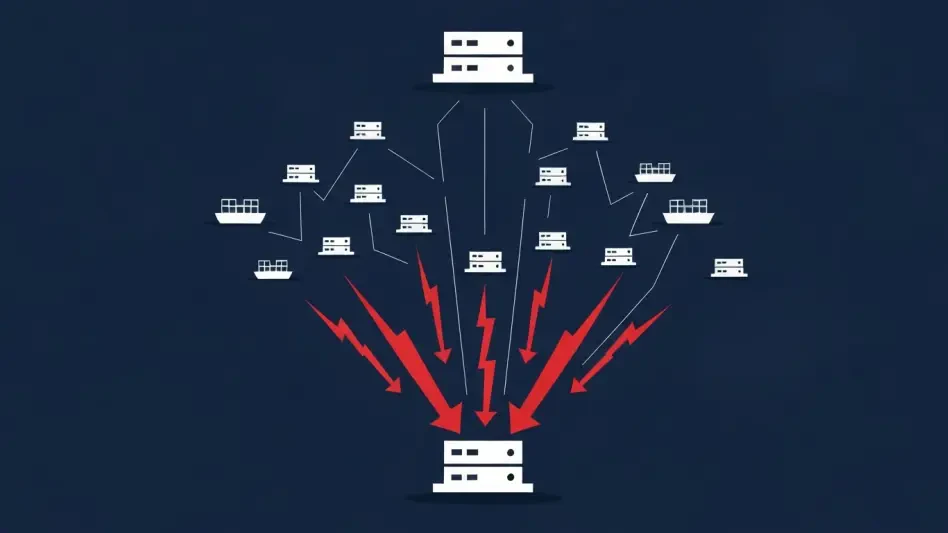In an era where cloud and AI technologies underpin nearly every facet of digital infrastructure, a staggering statistic emerges: over 80% of enterprises now rely on cloud-hosted platforms for critical operations, amplifying the stakes when vulnerabilities surface. This dependency became starkly evident in a recent incident involving Smithery.ai, a prominent player in model context protocol (MCP) server hosting, where a flaw exposed over 3,000 servers to potential compromise, sending ripples through the industry and raising urgent questions about security in an increasingly interconnected landscape. This report delves into the nature of the vulnerability, the response from Smithery.ai, and the broader implications for cybersecurity in cloud and AI ecosystems.
Understanding the Landscape of Cloud and AI Security
The cloud and AI hosting industry has experienced exponential growth, becoming a cornerstone of modern technology across sectors like healthcare, finance, and education. With global spending on cloud services projected to surge in the coming years, platforms hosting AI and machine learning applications, such as MCP servers, are at the forefront of this transformation. Major players like Smithery.ai facilitate the deployment of complex models, enabling businesses to leverage cutting-edge algorithms for predictive analytics and automation while meeting the demands for scalability and efficiency in a competitive market.
Beyond the technological advancements, the industry is shaped by key segments, including infrastructure-as-a-service providers and specialized AI hosting solutions. MCP servers, which support contextual data processing for AI models, represent a niche yet vital component, often integrated with platforms like Smithery.ai to streamline deployment. As reliance on these systems grows, so does the complexity of managing vast datasets and ensuring seamless interactions between distributed environments, pushing companies to innovate continuously to stay ahead of evolving user needs.
Cybersecurity remains a critical concern in this space, with threats ranging from data breaches to application exploits and supply chain attacks. Protecting sensitive information and ensuring robust application security are paramount, especially as malicious actors increasingly target configuration weaknesses and over-privileged credentials. The stakes are high, as a single breach can cascade through interconnected systems, underscoring the urgent need for comprehensive security frameworks to safeguard both providers and end users in this dynamic field.
Unveiling the Smithery.ai Vulnerability
Nature and Impact of the Path Traversal Flaw
At the heart of the incident was a path traversal vulnerability embedded in Smithery.ai’s MCP server build process, specifically tied to the configuration file known as “smithery.yaml.” This file, used when server owners submitted their setups via GitHub repositories, contained a property called “dockerBuildPath” that defined the location for Docker builds. Researchers found that by manipulating this property to reference paths outside the intended repository—using a simple “..” notation—attackers could access unauthorized areas of the builder machine.
This flaw opened a dangerous door to sensitive files, including the home directory and a critical “.docker/config.json” file, which harbored a fly.io authentication token. Possession of this token granted extensive control over Smithery.ai’s fly.io Docker container registry and allowed manipulation of hosted applications through the fly.io machines API. The potential impact was staggering, as over 3,000 servers, primarily MCP instances, faced exposure to unauthorized access and possible compromise.
The ramifications of such a vulnerability extend beyond mere data theft, as attackers could have altered application behaviors or injected malicious code into live environments. This type of path traversal exploit highlights a fundamental risk in build processes where user inputs are not adequately validated. For an industry reliant on trust and uptime, this incident serves as a stark reminder of the fragility inherent in complex deployment pipelines.
Discovery and Scale of the Risk
The vulnerability came to light through the diligent efforts of security researchers at GitGuardian, who uncovered the flaw during a routine analysis of configuration risks in cloud platforms. Their findings revealed not just a theoretical exploit but a tangible threat to thousands of hosted applications, many of which underpin critical business functions. The sheer scale of exposure—over 3,000 servers at risk—underscored the potential for widespread disruption if the flaw had been exploited by malicious entities.
Fortunately, investigations following the discovery found no evidence of prior exploitation by unauthorized parties, offering a sliver of relief amidst the gravity of the situation. However, the incident exposed how a single misconfiguration could jeopardize an entire ecosystem of applications. The risk was not merely technical but also reputational, as trust in hosting providers hinges on their ability to secure client assets against such threats.
This discovery also illuminated the importance of proactive security research in identifying hidden weaknesses before they are weaponized. The scale of the potential impact serves as a wake-up call for the industry to prioritize rigorous testing and monitoring of build environments. It emphasizes that even in the absence of immediate harm, the latent danger of such flaws demands swift and decisive action to prevent future crises.
Smithery.ai’s Response and Resolution
When GitGuardian responsibly disclosed the vulnerability to Smithery.ai on June 13, 2025, the company’s response was both prompt and exemplary. Within 48 hours, by June 15, 2025, Smithery.ai had rotated the exposed fly.io authentication token, effectively neutralizing the immediate threat posed by the compromised credential. This rapid action minimized the window of opportunity for any potential exploitation, showcasing a commitment to client safety.
In parallel, the company addressed the root cause by patching the path traversal flaw in the build process, ensuring that the “dockerBuildPath” property could no longer be manipulated to access unauthorized locations. This fix involved implementing stricter input validation and sandboxing measures to confine build operations within safe boundaries. Such steps reflect a model of effective vulnerability management that other organizations can emulate when facing similar challenges.
The collaboration between GitGuardian and Smithery.ai exemplifies the value of responsible disclosure and partnership in the cybersecurity realm. By working together, researchers and vendors can mitigate risks without causing undue panic or disruption to end users. This incident highlights that timely communication and coordinated action are indispensable in maintaining the integrity of cloud-hosted environments, reinforcing trust in an industry often under scrutiny for security lapses.
Broader Security Challenges in Cloud-Hosted AI Platforms
The Smithery.ai incident casts a spotlight on pervasive risks in cloud and AI ecosystems, particularly around supply chain security. MCP servers and similar platforms often rely on intricate networks of third-party tools and services, creating multiple points of vulnerability. A single weak link, such as an over-privileged credential or misconfigured file, can provide attackers with a gateway to compromise entire systems, as nearly happened in this case.
Further complicating the landscape are challenges like inadequate access controls and the absence of regular credential rotation. Many organizations, under pressure to deploy rapidly, overlook the principle of least privilege, granting excessive permissions that amplify the impact of a breach. Additionally, configuration files like “smithery.yaml” are often treated as secondary concerns, despite their potential to serve as entry points for sophisticated attacks if not properly secured.
To counter these threats, adopting robust strategies is essential, starting with enforcing least-privilege access to limit damage from compromised credentials. Secure coding practices, including thorough validation of all user inputs, must become standard to prevent exploits like path traversal. Regular audits of supply chain dependencies and proactive monitoring for anomalous behavior can also help detect and mitigate risks before they escalate, fostering a more resilient infrastructure for AI and cloud services.
Implications for Cybersecurity Practices and Regulations
The regulatory landscape for cloud and AI platforms is evolving, driven by incidents that expose gaps in current frameworks. Governments and industry bodies are increasingly advocating for stricter security standards to protect sensitive applications from vulnerabilities like the one seen at Smithery.ai. Compliance with emerging guidelines will likely become a baseline expectation, pushing organizations to prioritize security as a core component of their operations rather than an afterthought.
Secure configuration management stands out as a critical area for improvement, with the need to validate and sanitize user inputs in files and build processes becoming non-negotiable. The Smithery.ai flaw demonstrated how easily a simple oversight can lead to catastrophic exposure, prompting calls for standardized protocols to govern how configurations are handled. Such measures could prevent similar incidents by ensuring that potential attack vectors are identified and addressed during development cycles.
Looking ahead, this incident may catalyze the development of new regulations or industry guidelines aimed at enhancing accountability among cloud and AI providers. There is growing consensus that mandatory reporting of vulnerabilities and breaches, coupled with enforceable penalties for non-compliance, could drive better practices. As the stakes of digital infrastructure rise, aligning operational policies with regulatory expectations will be crucial to safeguarding user trust and system integrity.
Future Outlook: Securing AI and Cloud Ecosystems
As the industry progresses, balancing the rapid advancements in AI with robust cybersecurity measures remains a pressing challenge. The dual role of AI—both as a tool for enhancing threat detection and a potential source of new risks—adds complexity to this equation. A recent Red Canary survey noted that while many cybersecurity leaders see AI as a vital ally against escalating threats, a significant portion also worry about over-reliance eroding human oversight, pointing to a nuanced path forward.
Emerging trends suggest that innovations in access control, such as dynamic authentication and zero-trust architectures, will play a pivotal role in securing cloud and AI environments. These technologies aim to minimize static credentials and enforce continuous verification, reducing the likelihood of breaches stemming from stolen tokens. Additionally, integrating AI-driven anomaly detection with human judgment can create a hybrid defense mechanism capable of adapting to evolving threats.
Proactive threat management will be equally important, requiring organizations to anticipate risks rather than merely react to them. Investments in training, simulation exercises, and cross-industry collaboration can build resilience against sophisticated attacks targeting AI ecosystems. By fostering a culture of vigilance and innovation, the sector can navigate the delicate balance between leveraging cutting-edge tools and protecting against the vulnerabilities they introduce.
Key Takeaways and Recommendations
The Smithery.ai incident offers critical lessons for the cloud and AI hosting industry, chief among them the necessity of rapid response to identified vulnerabilities. The successful mitigation within days of disclosure demonstrates that timely action can avert disaster, even when the potential impact spans thousands of servers. It also underscores the value of robust security measures as a foundation for maintaining operational continuity in high-stakes environments.
Organizations are encouraged to implement least-privilege access as a default policy, ensuring that credentials and permissions are tightly controlled to limit exposure. Regular audits of systems and configurations, paired with secure development practices, can help identify weaknesses before they are exploited. These steps, while resource-intensive, are indispensable for preventing flaws like path traversal from compromising entire ecosystems.
Reflecting on this event, the industry stands at a crossroads where accountability and collaboration are key to building trust. By learning from such incidents, stakeholders can strengthen defenses and prioritize security as an integral part of technological progress. The path forward lies in collective efforts to address systemic risks, ensuring that the promise of AI and cloud innovation is not overshadowed by preventable lapses.
In wrapping up this analysis, the response to the Smithery.ai vulnerability proved that swift collaboration between researchers and vendors could effectively neutralize significant threats. Looking back, the incident highlighted actionable pathways for improvement, such as embedding security into every stage of development and deployment. Moving forward, a focus on integrating advanced access controls and fostering industry-wide standards offers a blueprint for preventing similar exposures, ensuring that lessons learned translate into tangible safeguards for the future.








